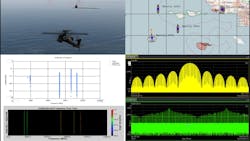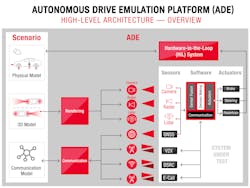Keysight Technologies' Gabriella Bailado dives deep into test and measurement trends
SANTA ROSA, Calif., - Keysight Technologies, Inc., a leading technology company in Santa Rosa, Calif., delivers advanced design and validation solutions to help accelerate innovation to connect and secure the world. Test and measurement equipment is integral to mission readiness as today's warfighters are enabled by an incredible amount of technology.
Soldiers, sailors, Marines, airmen, and space warfighters must have confidence that these machines of war will operate as intended, and their armaments will work when needed. To meet that goal, the U.S. Department of Defense (DOD) and its private-sector partners rely on accurate test and measurement equipment.
Military + Aerospace Electronics reached out to Keysight Technologies this fall to hear their insights in the test and measurement space as well as the importance of that equipment being accurate.
Speaking with associate editor Jamie Whitney, Keysight's Gabriella Bailado, the company's business development manager for radar and electronic warfare, took a deep dive into trends in military-aerospace test and measurement technology.
Military + Aerospace Electronics: Why is having highly accurate test equipment crucial to success?
Bailado: As electronic components and systems continue to evolve to higher levels of performance, we see increased demand for more accurate test equipment. Highly accurate test equipment is a critical aspect in the early planning stages of any product development cycle. The risk of including test equipment as an afterthought or incorporating inaccurate test equipment can be directly correlated to higher risks of failure and schedule slips. In R&D, better test equipment yields a better understanding of the true performance of prototype products. In manufacturing, reduced uncertainty margins can make a difference on production yields by reducing the number of false failure measurements. In system integration and system verification, highly accurate test equipment reduces error and uncertainty prior to the system going operational. As an example, when a signal generator provides an RF signal, if the phase or amplitude is off, this could translate to mile of inaccuracy (e.g., azimuth or distance to target) for a radar-warning-receiver detecting a threat.
Military + Aerospace Electronics: How can oscilloscopes, spectrum analyzers, software-defined test and measurement equipment contribute to readiness in mil-aero?
Bailado: Modern devices have higher levels of integration and complexity compared to previous generations. Higher integration and complexity of devices is driven by the desire to increase performance while simultaneously decreasing size, weight, and power (SWaP). Modern transmit/receive modules either have integrated antenna elements or have high port counts to drive multiple elements of phased-array antennas. Higher performance often results from devices operating in higher frequency bands with wider, often multi-GHz, bandwidths. Also, higher performance is often accompanied by more complex, digitally modulated signals compared to earlier systems. Higher device integration and performance has impacted the way devices are tested. Integrated antennas mean over-the-air testing is more common. On any given device, more test parameters are required for full device characterization, and this often requires high-performance instruments to cover the frequency range and bandwidth requirements. There is an emerging need to test mixed RF and digital devices, where RF is on one end, and bits on the other.
Multi-domain test and measurement equipment will be a requirement to address these complex AD systems across the industries. Measurements at microwave frequencies have historically been completed with traditional microwave test equipment like signal analyzers and vector network analyzers. Both tools can provide high-performance measurement capabilities, especially with the ability to stream at high rates with captured and recorded data, as the need for more data continues to grow. Tools to capture and autonomously analyze data will help to: speed up time, obtain the time from capture, as well as analyze from test/reprogram - operational.
In recent years, oscilloscope multi-GHz bandwidth and multi-channel capabilities have grown tremendously, making them extremely useful tools in the microwave and even millimeter wave domain. Nowadays, the traditional divide between time domain measurements and microwave measurements has been erased.
Military + Aerospace Electronics: Are there any trends you are noticing, or your company is help driving, in the test and measurement sector?
Bailado: Modern warfare has been redefined over the past couple of decades. Today’s conflicts often involve a mix of state and non-state actors and can be highly asymmetric with no clear lines of delineation. Quite often, non-state actors exert their power by striking soft targets rather than directly confronting state-Keysight is helping drive the test solutions to address modern-day threats across the entire AD ecosystem by providing commercial off the shelf test equipment which can be fully integrated into full test bed solutions (mentioned below). The company is working side-by-side with the industry to deliver flexible and scalable test solutions to keep pace with the ever-evolving AD environment.
Keysight is leading the effort with AD customers as their increased focus is on test modernization and technology refresh. Many test and engineering labs have large installed bases of older test equipment which presents some challenges. It is difficult to maintain compatibility of software; many instruments are beyond support life and parts to repair equipment do not exist. Test modernization and technology refresh is driven by:
• New test capability
• Increased RF performance and faster measurement speeds
• New software-license flexibility, with transportable, networked, and USB-dongle licenses
• Improved common user interfaces
• Shared measurement science across platforms
• Reduced SWaP for smaller test footprints in factories, repair depots, ships, and subs
Adopting new test and measurement technology to keep up with evolving technology trends in mil-aero is not without challenges. Often, effort is required to maintain backward compatibility with legacy software, databases, and threat libraries. Keysight is working alongside the industry to help with a seamless migration to new and fully integrated test solutions.
There is also an increasing demand on software for complex modeling and simulation, but ultimately the software must be able to also go beyond M&S to transducing accurate test with RF. Keysight provides many test solutions to bridge the gap between M&S and RF test. One of many application areas Keysight focuses on are phase array antennas, as they are the enablers of next-generation wireless comms, signal intelligence and earth observation applications. Keysight is dedicated to providing design and test solutions for electronically steered antennas and related sub-systems.
Military + Aerospace Electronics: Are there any products that your company has put out that may help highlight trends in test and measurement?
Bailado: Keysight’s progress in providing very high-quality microwave signal generators and analyzers support the trends that adoption of commercial communications in the A/D ecosystem require by offering ability to characterize high frequency and bandwidth components to ensure they will support quality and reliability metrics. To highlight a few:
• Z9500 Simulation View Software. The software enables the rapid development, integration, and test of sophisticated electronic warfare systems. The open plug-in-based architecture allows users to incrementally build out an RF system development environment (SDE) specialized to their needs and budget.
• Keysight’s new phased array over-the-air (OTA) fast calibration and characterization solution reduces array calibration time from hours to minutes. The solution is comprised of Keysight hardware and software components including: N52xxB PNA/PNA-X vector network analyzers, S93070xB modulation distortion software, F9650A compact antenna test range, and VXG vector signal generators.
• Keysight capabilities for electronic system level modeling include: W4503E PathWave phased array simulation software which provides industry-leading speed and simplicity for phased array design, W4815B PathWave system design satellite bundle, and the W4811B PathWave system design aerospace defense bundle.
• Keysight Infiniium oscilloscopes provide multi-channel and multi-GHz analysis bandwidths for AD measurements. High-performance specifications along with segmented capture and digital down conversion allow users to make time and frequency domain measurements with bandwidths up to 110 GHz with one single instrument. There are several measurement software applications including complex pulse analysis, EVM, and vector signal analysis.
• Defense and commercial aerospace organizations are moving toward electric vehicles to reduce their reliance on fossil fuels and recognize the numerous other benefits electrifications offers. Fully electric vehicles tend to have fewer breakable parts demanding available spares, helping to lower vehicle maintenance costs. Solutions include:
• Keysight’s autonomous drive emulation (or ADE) is a lab-based solution for time-synchronized, closed-loop testing of autonomous vehicle systems. It generates vehicle-to-everything communication signals as well as signals representing objects present in the environment. Those signals are received by the vehicle’s sensors and processed by its perception and planning software. The real value of ADE is that it allows you to test vehicle operations as a whole – augmenting traditional open loop testing of individual modules associated with radar, Lidar, and communication links.
• Test of new high-power fast-charging systems will require solutions such as Keysight’s charging discovery system (or CDS). CDS decodes & measures communication and power signals to provide functional and interoperability test for R&D, manufacturing, and maintenance applications.
• Enabling development of new or improved cell chemistries and production of associated cells, modules, and packs requires a range of test solutions. Keysight’s portfolio includes solutions for prototyping new battery cells and manufacturing those cells. It also includes solutions for R&D and production testing of battery modules and packs. Solutions for testing battery packs can also verify the associated battery management system electronics which perform functions such as monitoring the state-of-health of cells composing the module or pack.
Military + Aerospace Electronics: Is there anything you’d like to add that I didn’t ask you about?
Bailado: A very new emerging trend is around the electrification of aerospace and defense applications. Introducing electric and autonomous vehicles will require extensive coordination between government authorities, corporations, and defense agencies. Regulatory bodies will have to develop certification requirements that ensure the safety of new electric-powered autonomous aircraft used for commercial aviation. Defense agencies will have to work with their contractor communities to ensure the safety and reliability of military platforms – ground, airborne, or maritime. In addition to ensuring safe and reliable operation of the vehicles, commercial aerospace and defense will both benefit from common standards that assure broad interoperability of various systems and subsystems.
• Three areas stand out where further technology advancements are needed for aerospace and defense to realize the benefits of electrification. The first is advancements relating to the safe and cost-effective operation of autonomous vehicles. The second is improvements in the energy-density of batteries, and the third is ensuring broadly compatible high-power charging protocols and standards.
About the Author
Jamie Whitney
Senior Editor
Jamie Whitney joined the staff of Military & Aerospace Electronics in 2018 and oversees editorial content and produces news and features for Military & Aerospace Electronics, attends industry events, produces Webcasts, and oversees print production of Military & Aerospace Electronics.

